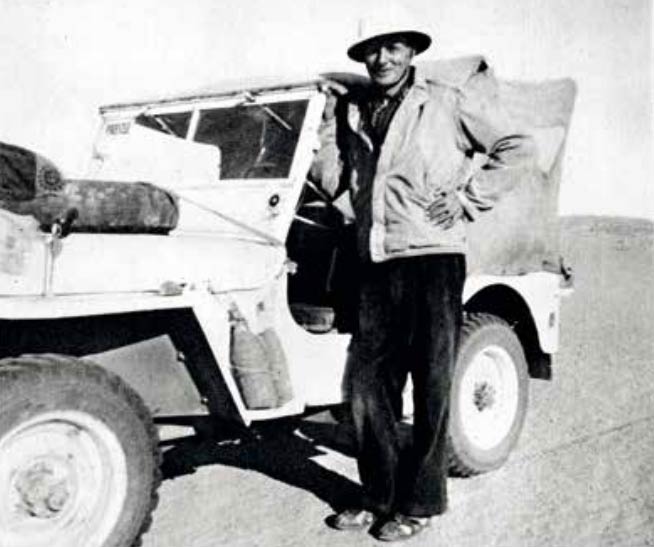'Le Mystère de la Vallée du Diable' (Spirou #35, 28 August 1941).
Joë Ceurvorst was a mid-20th century Belgian illustrator/reporter, whose drawings appeared in Spirou magazine and its Flemish edition Robbedoes during the period 1939-1946. As such, he was part of the first generation of local artists of this Belgian comic magazine, appearing alongside Rob-Vel, Davine, Jijé, Sirius, Fernand Dineur, Marcel Antoine, François Vanhamme, Joë Muray, Al Peclers and Charlie Delhauteur. There are uncertainties about Ceurvorst's identity. The author Frans Lambeau mentioned in his book 'Dictionnaire Illustré de la Bande Dessinée Belge Sous l'Occupation' (André Versaille Éditeur, 2013) that Joë Muray was a pen name of Ceurvorst and his real name was Joseph Demeulenaere. Another source mentions Raymond De Meulenaere as Joë Muray's real name. It is possible that the author used Muray to sign his more caricatural work and Ceurvorst for his realistic and journalistic work, but it is also still plausible that it were indeed two different persons. What is certain is that the man undertook his publicized 1950s African jeep expedition under the name Ceurvorst.
Header for 'La Saint Nicolas du soldat' (Spirou #49, 7 December 1939).
Early life and career
Joë Ceurvorst had an adventurous early life. He worked on a ranch in the Canadian Rocky Mountains when he was called back to Europe for his military service during World War I. Back in civilian life, he traveled through Africa, before returning to America and beginning his career in journalism. He came back to Europe in 1939, and started a collaboration with the publishing house Dupuis. One of his first jobs for Spirou magazine was illustrating the short text story 'La Saint Nicolas du Soldat' by editor-in-chief Jean Doisy in issue #49 of 1939. The illustrations for Doisy's serial 'O.K. Corrigan' (1939) are sometimes also attributed to him, but the artwork is credited to Joë Muray. In addition to Spirou, Ceurvorst also made illustrations for the other magazines of Éditions Dupuis, such as Les Bonnes Soirées.
'Le Péril Vert' (Spirou #11, 12 March 1942).
Paul Cartier
In 1941, Joë Ceurvorst drew two long comic stories with reporter/detective 'Paul Cartier' for Spirou: 'Le Mystère de la Vallée du Diable' (46 episodes, 1941) and 'Le Péril Vert' (34 episodes, 1941-1942). These stories appeared only in Spirou and not in the Dutch-language edition Robbedoes, and showed influences from both Hergé's 'Tintin' and Alex Raymond's 'Flash Gordon'. Remarkably enough, 'Paul Cartier' returned exclusively in Robbedoes in 1945-1946 with the new serial 'De Doodende Straal' (40 episodes, also known as 'De Meesters Van Den Doodenstraal'), which didn't appear in Spirou. Note that this post-war story was not a translation of one of the previous episodes, nor was it a reprint of the story of the same name which appeared in the Flemish ABC magazine in 1939 (drawn by Dutch artist Marten Toonder).
'De Doodende Straal' (Robbedoes #322, 20 June 1946).
Africa In A Jeep
In the second half of the 1940s, Ceurvorst was a journalist for Le Moustique and its Dutch-language edition Humoradio, writing reports about parts unknown, like the Far West or the Canadian Inuit population, as well as adventurous subjects like gliders and other scientific innovations. In 1949 and 1950, Ceurvorst undertook an expedition through the African continent in his Willys MB jeep, which he nicknamed "Mosquito". He was accompanied by his relative and secretary Jane Barbier and a dog called Pelish. He left on 1 May 1949, driving his jeep from Brussels to Marseille, from where he embarked for Algeria. On the African continent, he crossed the Sahara, the jungle regions of the Congo and the equatorial area, ending his adventurous trip in Usumbura (present-day Bujumbra) at Lake Tanganyika. The return trip went through the immense valley of the Nile to Alexandria. Almost a year since his departure, and after a journey of 35,000 kilometers (22,000 miles), he returned his jeep to the streets of Brussels.
Starting in April 1951, Ceurvorst's adventurous journey was chronicled in Le Moustique/Humoradio, Later, it was also collected in book format under the title 'L'Afrique en Jeep: Sahara-Niger-Congo-Nil-35.000 Km' (Hatier-Boivin, 1952). An English translation by Marvyn Savil called 'Africa in a Jeep' was published in 1956 by Staples Press. During the 1960s, Ceurvorst was additionally a translator of international novels for the publishing house Marabout, which included a new edition of Mary Shelley's 'Frankenstein, or The Modern Prometheus' (1964).
Later years
Ceurvorst spent his later years in Belgian Congo (present-day Democratic Republic of the Congo), working for the Info-Congo agency. In 1956, by request of the Office of Information and Public Relations for Belgian Congo, Ceurvorst crossed another 10,000 kilometers through Belgian Congo and Ruanda-Urundi. His mission was creating a written and visual documentary of the region, appearing in episodes in the newspaper La Dernière Heure. On 3 February 1959, the newspaper Le Soir mentioned that the Belgian Colonial Press Association had formed a board, with a Joe Ceurvorst serving as secretary general. His further whereabouts are unknown.
Joe Ceurvorst and his jeep Mosquito in Africa, 1950.







